 |
||
|
||
| ||
Multiprocessor motherboards are widely used for building high-efficient systems. However, when Intel processor with Coppermine core was released usage of multiprocessor configurations became hard. First, it's connected with the fact that the most popular chipset for dual-processor boards for processors Pentium II/III - Intel 440BX doesn't support FSB 133 MHz that is used by the latest processors Intel Pentium III. Secondly, not all old boards can be easily updated for the processors with a new core, and just a new version of BIOS might be not enough. So, when using the Intel 440BX you shouldn't use the processors with maximum clock speed higher than 600 MHz, or to decrease reliability having overclocked the system bus up to 133 MHz. Add absence of support for AGPx4 and Ultra DMA 66, and you will see that the chipset Intel 440BX needs to be replaced. Of course, Intel has released chipsets i820 and i840 but their price and orientation for RDRAM won't let them to become such popular as the 440BX. But there is an alternative - the chipset VIA Apollo Pro133A. And on the heels of Tyan, a well-known mainboard manufacture, Micro-Star company decided to release a board on the VIA Apollo Pro133A with support of two processors. The mainboard MSI 694D Pro is produced in several types: base (without additional controllers), with a controller Promise Ultra100 (version with index -A), with a controller Promise FastTrak100 (AR index). And other variants (which are only planned) are with controller FastWire / IEEE-1394 with two ports. MSI numerates the board as MS-6321. Technical characteristics
The board ships in a standard box. The complete set includes user's manual, D-LED systems, one cable for FDD and two UltraDMA66/100 for HDD. Beside drivers for chipsets, video and netcards a CD includes many programs such us 3D!Turbo, BUSRacing, DMI Browser, Doctor Y2K, EZLogo, Fuzzy Logic, Live BIOS, MoSpeed, PC Alert, SoftCooler. But because of a non-standard clock oscillator the most interesting of them - for processor speed control - don't work. For variants of boards with Promise ATA100 controller there is a manual and a driver set. InstallationIn general, the board has a standard ATX layout. But there are some differences. First, usage of two processors allowed only 5 PCI and one AGP slot. That's why they are all shifted downward (in case of Tower system block) and AGP card is put in the second connector from above and not in the first ATX one. In particular, the installed full-sized AGP video card won't prevent change of memory modules. Secondly, with an additional Ultra ATA/100 controller the board is equipped with 4 IDE connectors and when using three of them the cables entangle. Cables from Ultra ATA/100 ports complicate memory modules installation in the last two connectors. Besides, you can't install big fans such as Thermaltake Goden Orb. When using one processor on a dual-processor board it is necessary to install a special bracket in the second connector - a terminator. The MS-6321 has an integrated automatic bus terminator AGTL+, thus solving the problem of usage of one processor. The board has a couple of jumpers which are charged with FSB frequency adjustment from the set: auto, 66->100, 100->133, 133->100, 133->66, 100->66. Besides, there is a jumper for CMOS cleaning. Since the system doesn't have an automatic system for cleaning of CMOS parameters in case of unsuccessful overclocking, this jumper turns to be useful. The North Bridge of the chipset has a small heatsink. The BIOS chip is installed on a plate what makes unnecessary its unsoldering in case of record of a wrong BIOS firmware upgrade. The board is equipped with a speaker which can substitute for a speaker in a case. Note an unusual (vertical) mounting of a battery. Near the connectors of case indicators you can find LED polarity. In general the layout is quite convenient. The only downside concerns location of power supply connector - with two processors onboard it's quite difficult to uninstall it in case the board isn't on a sliding panel.  The diagnostic system D-LED is used for solving problems occurring while computer booting before OS (such problems as errors in installation of processors, chipsets, memory, FDD/IDE controllers, BIOS failure, problems with video etc.). Four two-color LEDs are located between connectors for printer and game port. We should notice a considerable inaccuracy of measurements of temperature sensors. On the other hand, with only one processor, the second sensor can be used for measurements inside the case. The same concerns fans - since there is no speed diagnostics you can use the second connector if it's free. In the tests the board has proved its reliability. Quite often reliability is connected with capacity and the number of capacitors installed onboard, so: there are 11 capacitors of 2700mF and 1500mF. The downside is that when using a netcard Compex FL100 on the Intel 21143 while booting the table of configurational system doesn't appear and the BIOS refuses switching on processor caches. And the PC works at 20 XT. Usage of other PCI boards doesn't cause any problems (video, other netcard, modem). Overclocking possibilitiesThe board is equipped with jumpers which set preliminary FSB value (66/100/133), they also define a FSB/PCI frequency devisor (AGP frequency always equals twice PCI frequency). Then we can change FSB frequency in the BIOS from the following set (FSB/PCI, MHz):
Note that in the BIOS SETUP there are several extreme variants with ratio equal 5. Unfortunately, usage of a new clock oscillator on the chip IC-Works W225H didn't let us to carry out more proper investigation. According to MSI this chip was produced under a special order, also to provide FSB:PCI ratio equal to 5 what is not standard for the chipset VIA Apollo Pro 133A. You can change Vcore voltage in the range -0.1, -0.05, +0.05, +0.1, +0.2, +0.4 V. We managed to overclock the Intel Pentium III 600E on this board up to 882 MHz (=147x6), however with Vcore increase in 0.1 V. Quake3 test results on a dual-processor configuration at this frequency are shown below. When we tried a faster variant with FSB:PCI ratio equal to 5 the system buzzed while processor initialization. Vcore change, chipset cooling or memory deceleration didn't help us. TestsWe tested VIA Apollo 133A based boards many times, that's why here we will pay special attention to dual-processor feature. The testbed:
For the tests we used such programs as High-End Winstone and Dual-Processor Inspection Tests from the set ZDLabs Winstone 99 1.3, and Quake3 Arena game which is also equipped with dual-processor support. The majority of applications of the High-End Winstone
99 do not take into account dual-processor feature (the growth is
about 6-8%), that's why in order to estimate general performance
we will show you the figures obtained when working on one processor:
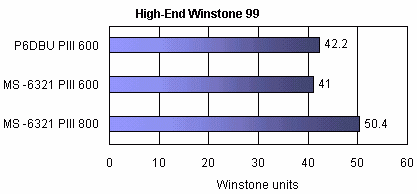 As you can see the MS-6321 motherboard lags behind a classic variant of a server board on the Intel 440BX by just a little margin. It confirms that the VIA Apollo Pro133A is a bit slower then the Intel 440BX. And if using the chipset VIA working with the memory at 133 MHz and 100 MHz FSB the result will become similar - High-End Winstone 99 will be 42.1. For dual-processor systems ZDLabs uses a special set of tests with such programs as MicroStation SE, Photoshop 4.0 and Visual C++ 5.0:
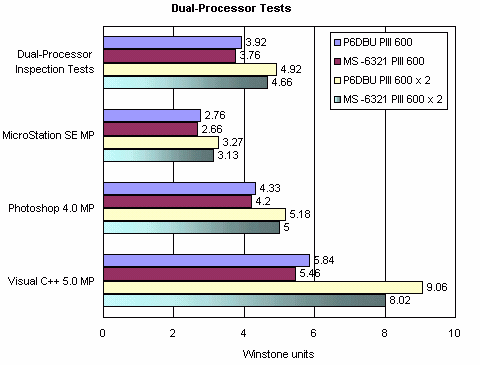 As you can see, the MS-6321 falls behind the P6DBU by 12% (in the last test). It's quite considerable difference. It seems that VIA didn't succeed in getting good speed on this chipset. That's why there are too less dual-processor boards on the VIA than on the Intel 440BX. On the other hand, considering the price (for the MS-6321 it starts from $160) this board can serve a good platform for servers of entry level. We used Quake3 Arena in order to test speed (1.16n game version and demo q3crush.dm3). While testing we switched off the sound (s_initsound 0, snd_restart) and SMP support (r_smp 1, vid_restart). We used not very complicated video settings for the videocard parameters not to restrict the speed too much:
Processor utilization doesn't practically depend on the resolution. That's why if the video card is "faster" than the processor (video card outputs frames faster than the CPU process them) the speed is defined by the processor. And we can see that with increasing of graphics resolution the speed doesn't practically falls. And when raising the CPU speed FPS goes up. Here are the results:
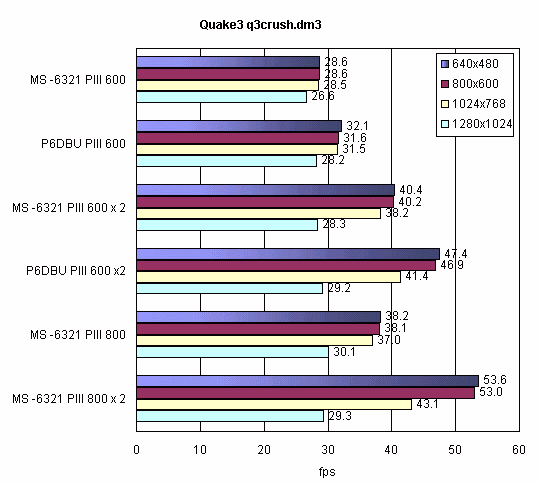 In this test the advantage of P6DBU became clearer. The biggest gap constituted 17% in dual-processor configuration. Now you can see the results for the MS-6321 in another form: 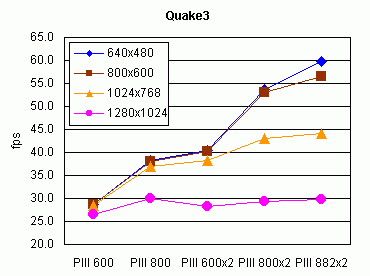 The speeds at 640X480 and 800X600 are practically similar. It means that fps can grow with increase in processor(s) speed. The speed at 1024X768 has nearly reached its limiting point - around 45 fps, and at 1280X1024 the video card can't work faster than 30 fps even with very rapid processors. Here you can see what we have received for a 3dimensional graphs : fps=min(CPU/20, 105-0.06*VideoMode), where CPU is processor frequency, VideoMode is resolution of the screen (X axis): 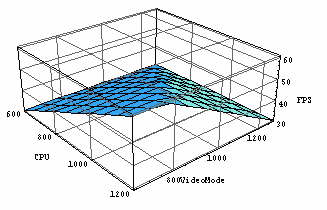 The video card sets an area of turquoise color, and a blue one is CPU speed (and a little of chipset, memory). In general the graph looks the same when changing a video card or a processor. For example, video on the chip NVIDIA GeForce2 Ultra can have speed approx 2.3 times higher than that of GeForce2 MX (1280x1024x16, PIII 1000), since for it the limitation of speed comes much later, and i.e. in 1024X768X16 mode one Intel PIII 1000 is not enough and usage of two processors can increase the speed even more. In a real system there are other limiting factors - bus of a processor, memory, AGP, video memory etc., however processor and video card speeds are the main factors. And processor power is needed not only for graphics but also for sound, communications and AI of your rivals. We can recommend two processors for users with video adapters of the latest generations. The test results show that dual-processor work can considerably raise performance in specially developed applications and games. There you can gain increase around 40% as compared with uniprocessor system of the same frequency (in case the speed is not limited by the video card). An analog growth of the system on the Intel 440BX makes even 47%, so VIA still have to work on dual-processor configurations. Unfortunately, today only Quake 3 Arena and games on its engine support multiprocessor systems. ConclusionWell, in general the board proves to be rather
reliable. Such features of the chipset VIA Apollo Pro133A as FSB
133 MHz, PC133 memory, 5 PCI BusMaster devices, AGPx4, Ultra DMA
66, maximum size of RAM 2 GBytes, 4/3 and 2/3 multipliers for memory
bus, 4 USB ports, together with installation of two processors and
integrated Ultra ATA 100 or even RAID controller will let you use
the board for entry-level servers and high-efficient workstations
on the latest models of the Intel Pentium III.
Write a comment below. No registration needed!
|
Platform · Video · Multimedia · Mobile · Other || About us & Privacy policy · Twitter · Facebook Copyright © Byrds Research & Publishing, Ltd., 1997–2011. All rights reserved. |